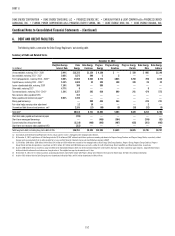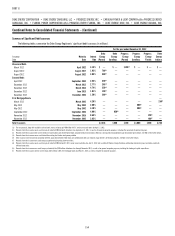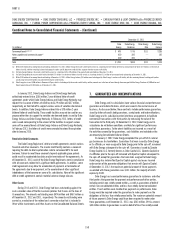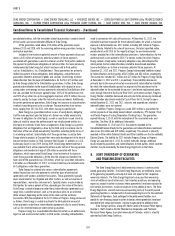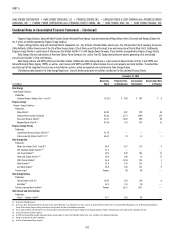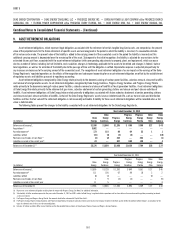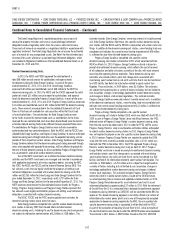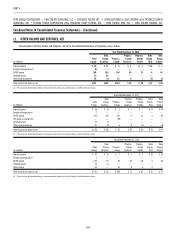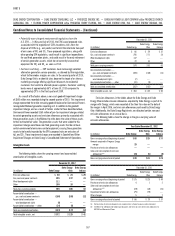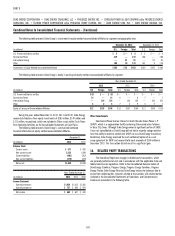Duke Energy 2012 Annual Report Download - page 179
Download and view the complete annual report
Please find page 179 of the 2012 Duke Energy annual report below. You can navigate through the pages in the report by either clicking on the pages listed below, or by using the keyword search tool below to find specific information within the annual report.
159
PART II
Combined Notes to Consolidated Financial Statements – (Continued)
DUKE ENERGY CORPORATION • DUKE ENERGY CAROLINAS, LLC • PROGRESS ENERGY, INC. • CAROLINA POWER & LIGHT COMPANY d/b/a PROGRESS ENERGY
CAROLINAS, INC. • FLORIDA POWER CORPORATION d/b/a PROGRESS ENERY FLORIDA, INC. • DUKE ENERGY OHIO, INC. • DUKE ENERGY INDIANA, INC.
consolidated entities, with the remainder related to guarantees issued on behalf
of third parties and unconsolidated affi liates of Duke Energy.
Of the guarantees noted above, $93 million of the guarantees expire
between 2013 and 2028, with the remaining performance guarantees having no
contractual expiration.
Included in the maximum potential amount of future payments discussed
above is $26 million of maximum potential amounts of future payments
associated with guarantees issued to customers or other third parties related to
the payment or performance obligations of certain entities that were previously
wholly owned by Duke Energy but which have been sold to third parties,
such as DukeSolutions, Inc. (DukeSolutions). These guarantees are primarily
related to payment of lease obligations, debt obligations, and performance
guarantees related to provision of goods and services. Duke Energy received
indemnifi cation from the buyer of DukeSolutions for the fi rst $2.5 million paid
by Duke Energy related to the DukeSolutions guarantees. Further, Duke Energy
granted indemnifi cation to the buyer of DukeSolutions with respect to losses
arising under some energy services agreements retained by DukeSolutions after
the sale, provided that the buyer agreed to bear 1 00% of the performance risk
and 50% of any other risk up to an aggregate maximum of $2.5 million (less any
amounts paid by the buyer under the indemnity discussed above). Additionally,
for certain performance guarantees, Duke Energy has recourse to subcontractors
involved in providing services to a customer. These guarantees have various
terms ranging from 2013 to 2021, with others having no specifi c term.
Duke Energy has guaranteed certain issuers of surety bonds, obligating
itself to make payment upon the failure of a former non-wholly owned entity
to honor its obligations to a third party, as well as used bank-issued stand-by
letters of credit to secure the performance of non-wholly owned entities to a
third party or customer. Under these arrangements, Duke Energy has payment
obligations that are triggered by a draw by the third party or customer due to
the failure of the non-wholly owned entity to perform according to the terms of
its underlying contract. Substantially all of these guarantees issued by Duke
Energy relate to projects at Crescent that were under development at the time of
the joint venture creation in 2006. Crescent fi led Chapter 11 petitions in a U.S.
Bankruptcy Court in June 2009. During 2009, Duke Energy determined that it
was probable that it will be required to perform under certain of these guarantee
obligations and recorded a charge of $2 6 million associated with these
obligations, which represented Duke Energy’s best estimate of its exposure
under these guarantee obligations. At the time the charge was recorded, the
face value of the guarantees was $70 million, which has since been reduced to
$1 8 million as of December 31, 2012, as Crescent continues to complete some
of its obligations under these guarantees.
Duke Energy has entered into various indemnifi cation agreements
related to purchase and sale agreements and other types of contractual
agreements with vendors and other third parties. These agreements typically
cover environmental, tax, litigation and other matters, as well as breaches of
representations, warranties and covenants. Typically, claims may be made by
third parties for various periods of time, depending on the nature of the claim.
Duke Energy’s potential exposure under these indemnifi cation agreements can
range from a specifi ed amount, such as the purchase price, to an unlimited
dollar amount, depending on the nature of the claim and the particular
transaction. With the exception of the $217 million at Progress Energy discussed
as follows, Duke Energy is unable to estimate the total potential amount of
future payments under these indemnifi cation agreements due to several factors,
such as the unlimited exposure under certain guarantees.
Progress Energy has issued indemnifi cations for certain asset performance,
legal, tax and environmental matters to third parties, including indemnifi cations
made in connection with sales of businesses. At December 31, 2012, the
estimated maximum exposure for these indemnifi cations for which a maximum
exposure is determinable was $2 17 million, including $42 million at Progress
Energy Florida. Related to the sales of businesses, the latest specifi ed notice
period extends until 2013 for the majority of legal, tax and environmental
matters provided for in the indemnifi cation provisions. Indemnifi cations for the
performance of assets extend to 2016. For certain matters for which Progress
Energy receives timely notice, indemnity obligations may extend beyond the
notice period. Certain indemnifi cations related to discontinued operations
have no limitations as to time or maximum potential future payments. At
December 31, 2012 and 2011, Progress Energy had recorded liabilities related
to indemnifi cations to third parties of $25 million and $63 million, respectively.
These amounts included $17 million and $37 million for Progress Energy Florida
at December 31, 2012 and 2011, respectively. These liabilities decreased
primarily due to the reversal of certain environmental indemnifi cation liabilities
for which the indemnifi cation period has expired and the adjustment to the
indemnifi cation for the estimated future years’ joint owner replacement power
costs through the end of the Crystal River Unit 3 joint owner contract. Progress
Energy Florida’s liabilities decreased primarily due to the previously mentioned
indemnifi cation adjustment related to Crystal River Unit 3. During the years
ended December 31, 2012 and 2011, accruals and expenditures related to
indemnifi cations were not material.
In addition, Progress Energy has issued $300 million in guarantees for
certain payments of two wholly owned indirect subsidiaries, FPC Capital I Trust
and Florida Progress Funding Corporation (Funding Corp.). The guarantees
expired February 1, 2013, with the redemption of the associated notes and
securities. See Note 18 for additional information.
At December 31, 2012 and 2011, the amounts recorded on the
Consolidated Balance Sheets for the guarantees and indemnifi cations mentioned
above was $4 1 million and $19 million, respectively. This amount is primarily
recorded in Other within Deferred Credits and Other Liabilities on the Consolidated
Balance Sheets. The liability for 2011 excludes Progress Energy as Progress
Energy was acquired July 2, 2012. As current estimates change, additional
losses related to guarantees and indemnifi cations to third parties, which could be
material, may be recorded by the Duke Energy Registrants in the future.
8. JOINT OWNERSHIP OF GENERATING
AND TRANSMISSION FACILITIES
The Duke Energy Registrants hold ownership interests in certain jointly
owned generating facilities. The Duke Energy Registrants are entitled to shares
of the generating capability and output of each unit equal to their respective
ownership interests. The Duke Energy Registrants also pays their ownership
share of additional construction costs, fuel inventory purchases and operating
expenses, except in certain instances where agreements have been executed to
limit certain joint owners’ maximum exposure to the additional costs. The Duke
Energy Registrants share of revenues and operating costs of the jointly owned
generating facilities is included within the corresponding line in the Consolidated
Statements of Operations. Each participant in the jointly owned facilities must
provide its own fi nancing, except in certain instances where agreements have been
executed to limit certain joint owners’ maximum exposure to the additional costs.
Duke Energy Carolinas, along with North Carolina Municipal Power Agency
Number 1, North Carolina Electric Membership Corporation and Piedmont
Municipal Power Agency, have joint ownership of Catawba, which is a facility
operated by Duke Energy Carolinas.





